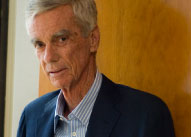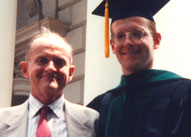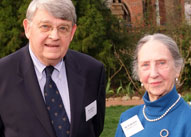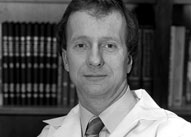

| Fall 2008 | ||||||||||||
| Current Issue | ||||||||||||
| The Hidden Truth about Alcohol A Voice for Grady The Trouble with Vaccine Trials Love Affair with the Heart Dean's Mesage In Brief Gifts and Support |
||||||||||||
| Past Issues Other Publications Contact Us Make a Gift SOM home |
||||||||||||
|
||||||||||||
Ira A. Ferguson Sr., 23M, never shied away from doing the hard stuff. He helped his parents run a farm and dry goods store in his native Alabama. He drove an ambulance during World War I and preserved cadavers to help pay for medical school before transferring to Emory. The first of three generations to attend Emory, Ferguson established a private practice and became a professor and chief of surgery at Grady Hospital. In the process, he tended the wounded during both world wars in Europe and championed the education of African American physicians in the segregated South.
As a tribute to his late father, retired Emory surgeon Ira Ferguson Jr., 52M, provided a $250,000 gift to create the annual Ira A. Ferguson Lecture. In the first talk this year, Charles Ferguson, 76M—Ira Jr.’s son and a former Emory surgeon who now teaches at Harvard—traced his grandfather’s role in what he calls “the other Tuskegee experiment,” an event overshadowed by the infamous syphilis study of black sharecroppers from 1933 to 1972.
To supplement his income after World War II, Ira Sr. consulted for the Veterans Administration (VA), inspecting hospitals throughout the Southeast and conducting disaster-training courses for national defense. During visits to the Tuskegee VA Hospital, Ferguson befriended Asa Yancey, an African American physician from Atlanta and the hospital’s new chief of surgery. Yancey was eager to establish a surgical residency program but lacked the required teaching resources. Ira Sr. stepped up and organized a team from Emory to teach at Tuskegee once a week. Thus, Ferguson helped establish Alabama’s first surgical residency program for African American physicians in 1948.
Ten years later, Ferguson convinced Yancey to return to Atlanta as director of the Hughes Spalding Pavilion, which served black patients at Grady. Yancey subsequently became medical director at Grady and professor and associate dean of the medical school at Emory.
“Why did a young man from a small town in Alabama spend such time and effort in helping develop surgical training programs for African Americans?” asked Charles during the Ferguson lecture. “He had to overcome obstacles himself and was compelled to make things easier for others. Few 46-year-old surgeons with a successful practice would volunteer for overseas military duty, much less accompany a beach invasion force at age 49 [during World War II], with two teenage boys to support. Perhaps through such self sacrifice, one learns to truly serve others.”

| ny | tiny font | ny |
| Andrew McKelvey’s gifts to Emory have broadened the scope of caring for patients with lung disease. | ||
Andrew McKelvey was 12 the first time he became a household name by selling fresh eggs door-to-door in New Jersey. Today, he is known worldwide as founder of the online job search engine Monster.com.
Coupled with his knack for business is a belief in sharing his good fortune with others. In 2001, McKelvey made a $20 million commitment to establish the Andrew McKelvey Lung Transplantation Center. He recently gave an additional $5.4 million to grow transplant research and Emory’s ability to help patients with lung disease.
“His support has been remarkable for its impact,” says Clinton Lawrence, McKelvey’s friend and medical adviser for more than 25 years. Today Lawrence holds the Augustus J. McKelvey Chair in Lung Transplantation Medicine, named for Andrew’s late father, a general practitioner.
The two friends met in the early 1980s at Baylor College of Medicine, where McKelvey sought treatment for sarcoidosis. “I had received a grant from NIH to look at inflammatory lung diseases, and based on my research, I felt we could treat him with steroids and perhaps make him better,” says Lawrence. “We did, and he improved. He was very grateful and very interested in my research.”
At Emory, McKelvey’s $20 million gift is helping physicians develop new medical therapies for lung disorders—in hopes of eliminating the need for transplants—and new strategies to improve outcomes after surgery. The average number of patients receiving lung transplants annually has risen from 10 to nearly 30. Additionally, McKelvey’s initial gift has brought 12 new faculty to Emory and enabled young investigators like Allan Ramirez to launch their careers at a time when federal research funding is tight. A McKelvey Scholar, Ramirez is studying the underlying causes of lung transplant rejection and pulmonary fibrosis. He is among several McKelvey Scholars to receive federal grant support for research initially sponsored by the McKelvey Center.
More recently, McKelvey’s $5.4 million gift has broadened the scope of both clinical care and laboratory research. To reflect this growth, the lung transplant center has been renamed the McKelvey Center for Lung Transplantation and Pulmonary Vascular Diseases. Current research includes basic studies of the immune response to transplantation, multicenter clinical trials of new medications for lung transplantation, and treatment of pulmonary hypertension. The center continues to assist Georgians in need of lung transplants and who often cannot afford the cost.
McKelvey cites two reasons for his philanthropy to Emory. “If you make money in this country, you need to give it back,” he says. “And Clint did a good job and improved my health.”
The return on McKelvey’s investment in lung transplantation research and patient care is immeasurable, says Lawrence. “The benefits to individual lives and scientific discovery may go on forever.”

| ny | tiny font | ny |
| Garet Pilling (left) has created a scholarship honoring his late son. ”Keith took our breath away,” says Pilling. | ||
By all accounts, Keith Pilling, 92M, treasured being a doctor. An interventional radiologist, he was regarded as an excellent clinician, diagnostician, teacher, and mentor by his patients and colleagues in and around Medford, New Jersey.
Less than 10 years after graduating from medical school at Emory, Keith died of a rare pancreatic tumor in 2001 at age 35. At the time of his death, he had two young sons with his wife, Jennifer Kraus, 92M.
“There is a famous quote that states, ‘Life is not measured by the breaths we take, but by the moments that take our breath away.’ Well, Keith always took our breath away,” says his father, Garet Pilling. “He was a wonderfully gifted man with a passion for life like I have never seen. He was an amazing son, husband, brother, and father. His life was so full of promise. Keith had every gift but length of years.”
Now retired, Pilling is the former CEO of Park Steel & Iron Company of Neptune, New Jersey. Founded by his father in the early 1900s, the company is now led by Pilling’s son Scott. Pilling, along with Scott and his daughter Laurie, were present the day Keith graduated from medical school. “We were all so very proud of him and knew that he had the fortitude to make it through the grueling years of residency, internships, and fellowships,” says Pilling.
“I can give Keith no greater compliment than to say he was an extremely good man,” says Laurie Pilling, who practices law in New Jersey. “He was loving and compassionate, and his brotherly advice and guidance will always be missed.”
To honor Keith’s memory, Garet Pilling has made a $1 million commitment to establish the Dr. G. Keith Pilling Scholars Endowment. Once established, the full scholarship will be awarded to an Emory medical student who demonstrates merit and need. Members of the Class of 1992 will be invited to contribute to the scholarship as well.
“I am giving this gift to Emory School of Medicine because my son, my friend, died,” says Pilling. “I hope I will be able to help those who have the same passion about medicine as Keith did. Sadly, he was taken from us too early, and he could not fulfill all of his dreams. I hope that those who receive this gift will be able to fulfill theirs.”

| ny | tiny font | ny |
| Frank and Ann Critz |
Frank and Ann Critz recently provided a $2 million gift to create the Alfred W. Brann Jr. Chair in Pediatrics for Reproductive Health and Perintal Care. Brann mentored Ann during her residency in the early 1980s. She is now associate professor of pediatrics. Pictured with Brann is neonatology pioneer Mildred Stahlman, his mentor at Vanderbilt.
Putting where it counts
If it weren’t for a group of Atlanta golfers, pharmacologist Haian Fu might not have pinpointed how the 14-3-3zeta protein promotes lung tumor formation. His discovery, published in last year’s Proceedings of the National Academy of Sciences (PNAS), may lead to new anti-cancer drugs targeting the protein.
Using seed funding provided by Atlanta Golfers Against Cancer (GAC), Fu conducted a pilot study, the results of which helped secure major funding from the NIH and other sources for his study.
Fu is one of 10 Emory Winship Cancer Institute researchers to benefit from GAC support. To date, the group has donated more than $500,000 in seed funding for bench research, supplemented by matching funds from Winship and other sources.
Support from GAC is vital, enabling Winship scientists to pursue what Fadlo Khuri calls “high-risk research”—novel studies that are less mainstream and more difficult to fund. “The support that GAC provides leads to substantial peer-reviewed funding from the NIH, the American Cancer Society, the Department of Defense, and other sources,” says Khuri, chair of the Department of Hematology/Oncology and a collaborator on Fu’s study.
Khuri first worked with GAC while on staff at M.D. Anderson Cancer Center in Houston. The organization was formed there in 1997 when members of a local golf club banded together to support club and staff members diagnosed with cancer. Nationally, GAC has raised more than $10 million through city chapters.
The Atlanta GAC supports research at Winship and the Ovarian Cancer Institute laboratory at Georgia Tech.
“We continue to fund projects at both institutions because they are top quality,” says John Ray, an Atlanta-area entrepreneur whose first wife died of pancreatic cancer. “Winship has been very active in attracting top-notch research professionals around the country. I’m very optimistic about the future of Winship and the results of the work being done there today. We want to accelerate those results as much as we possibly can.”

| ny | tiny font | ny |
| Ellis L. Jones | ||
When Ellis L. Jones, 63M, was in medical school, he received a scholarship that allowed him to pursue research. Jones went on to become a renowned cardiothoracic surgeon at Emory, but he never forgot the financial freedom the scholarship brought so he could follow his true calling.
“It just meant the world to him,” says Beth Jones of the scholarship to her late husband, who died of cancer in 2007.
To honor him, the family has joined more than 100 friends to create a scholarship in his name. They hope it will do for a medical student what Jones’ scholarship did for him—provide the ability to pursue research without financial concern. Next spring, a fourth-year medical student who is pursuing promising cancer research will be selected as the first recipient.
Among his talents, Jones was known for his perfectionism in the OR and his joy in teaching residents his beloved craft of heart surgery. He trained dozens of them in the more than 30 years he served on the faculty.
The surgeons whom Jones trained had a tough act to follow. In 1977, he received a Tiffany clock with the inscription, “To Ellis Jones on the occasion of performing 350 consecutive and successful open heart procedures without a single death with the admiration of the whole group.”
Through the Ellis L. Jones MD Scholarship for Oncology Research, Mrs. Jones hopes a medical student someday will make contributions to the field of cancer research that will gain the admiration of colleagues and peers alike.—Kay Torrance
To make a gift to the Ellis L. Jones MD Scholarship Fund, contact Vicki Riedel at 404-778-5939 or vriedel@emory.edu.
Back to Top | SOM home
© 2008. Emory University, All rights reserved.